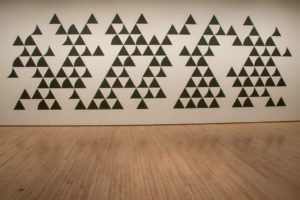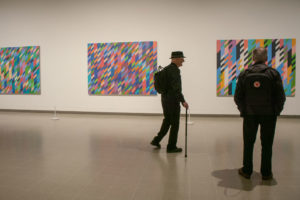

I first came across Dahlias in my ex mother-in-law’s garden. She had a beautiful herbaceous border just outside the kitchen window. She said she just bunged plants in but I think she did a bit more than that as it always looked fantastic. And the Dahlias were to die for. I loved their intense and unapologetic colour and their almost but not quite perfect symmetry. When I started designing textiles, I knew that one day I would do something with Dahlias. And so I have.
There is something almost otherworldly about a Dahlia flower head don’t you think? Which is why I decided just to use the heads and dispense with the rest. I love a big, bold pattern and as Dahlias are uncompromisingly showy, I made Dahlia Grandiflora big and bold. When the samples came back from the mill, I was very well pleased with the result. I showed it proudly to my mother. She looked at it a moment and then pronounced, “…that pattern is too big”. Oh, I deflated a little, but only a little. I knew that the pattern worked. But I did take her point that perhaps for some people, the pattern is, well, just too big. I experimented and made it smaller. When Dahlia returned from sampling, I was very well pleased with the result. The intensity of the colours and their relationship to one another in the smaller pattern evoke a very different feeling from its big blousy sister. Although I know it to be true, again and again I am struck by the power of colour to engage with our senses and to elicit emotion. And nowhere can this be experienced more powerfully or more viscerally than in the work of Bridget Riley.
 The Hayward Gallery in London is showing a retrospective of her painting. Off I went with my friend E. I was perhaps not in the best form to be visiting a Bridget Riley exhibition as I had the beginnings of a headache. I had known of her as an Op Art artist but as I had never had the opportunity before now to see her work in person, I had no real conception of its power. Reproductions in books really have nothing on the scale or intensity of the real thing. The effect of gazing on her work is truly a visceral one and in the first instance did feel a little like an assault. I feared the onset of a worse headache. I had to turn away several times before the disturbance to my senses passed and I could look at the works in more depth.
The Hayward Gallery in London is showing a retrospective of her painting. Off I went with my friend E. I was perhaps not in the best form to be visiting a Bridget Riley exhibition as I had the beginnings of a headache. I had known of her as an Op Art artist but as I had never had the opportunity before now to see her work in person, I had no real conception of its power. Reproductions in books really have nothing on the scale or intensity of the real thing. The effect of gazing on her work is truly a visceral one and in the first instance did feel a little like an assault. I feared the onset of a worse headache. I had to turn away several times before the disturbance to my senses passed and I could look at the works in more depth.
 I found her monochrome works elegant, aloof and, which surprised me greatly, occasionally angry. I liked the interplay between the black and white, its timeless harmony, the effect of changes in scale, and the power of deceptively simple, elementary shapes deployed with precision and economy.
I found her monochrome works elegant, aloof and, which surprised me greatly, occasionally angry. I liked the interplay between the black and white, its timeless harmony, the effect of changes in scale, and the power of deceptively simple, elementary shapes deployed with precision and economy.
I don’t think I would have found her works in colour so impactful had I not seen the monochrome ones. Here, in the hands of a master, colour adds an extra dimension, forms part of the structure of the painting, creating its own syncopating rhythm in the simple form of a stripe, an effect more pronounced in what I think of as her later wave or fractured stripe works. I found her work elemental, all in some way revealing Nature, seeing the intense fresh greenness of Spring, the faded, sun-bleached colour of Summer, the deep richness of Autumn, and the dark storminess of Winter. I came away invigorated and my headache thankfully none the worse.
On reading the show catalogue on my return home, I was particularly struck by Bridget’s comment that, “… Sensation of colour is a different thing, it takes in attendant qualities, so to speak, such as glitter or sombreness, buoyancy or weight, dull glow or full brilliance, impalpability or density, softness or hardness – in short a surprising variety of sensual relationships.” (p. 119)
Colour’s ability to produce such varied sensations is perhaps why we are wary of it, intuitively recognising its fundamental power to produce feelings for good or ill. And why when choosing colours to wear, to sit on or to surround yourself with, your best guide is to trust how they make you feel.
Bridget Riley is on show at the Hayward Gallery, Southbank Centre, London, until 26 January 2020.
If you would like Musings to pop into your inbox every other week or so, you can subscribe here.